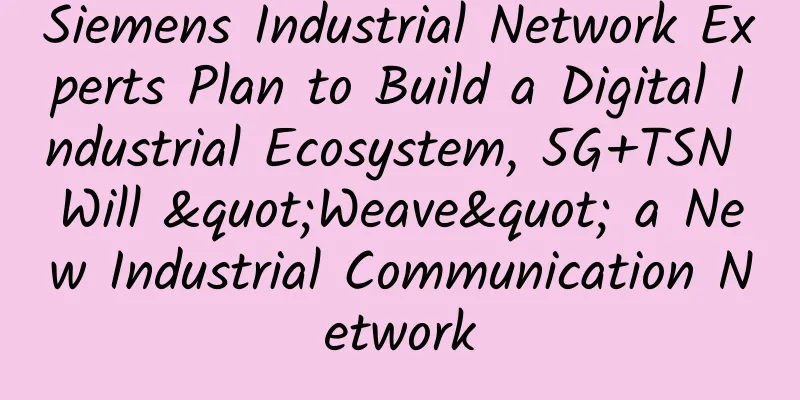Siemens Industrial Network Experts Plan to Build a Digital Industrial Ecosystem, 5G+TSN Will "Weave" a New Industrial Communication Network

|
[51CTO.com original article] On July 16, Siemens held the 2019 Industrial Network Expert Program Forum in Beijing with the theme of "Networking Industry, Seeing the Future". A year ago, Siemens officially launched the "Siemens Industrial Network Expert Program" in China, hoping to work with more partners through this program to jointly enhance the overall strength of China's industrial communications and pave the way for digital transformation in various industries. On the occasion of the first anniversary of the launch of the plan, Siemens discussed hot topics with more than 300 customers, OEM manufacturers, partners and distributors from the industry at the 2019 Industrial Network Expert Program Forum, looking forward to the future of industrial communications.
In the conference schedule, there are two major topics that have attracted great attention from the participants - one is the value that 5G brings to the industry, and the other is the mainstream technology trend of the future industrial communication architecture. These two topics are very consistent with the current hot topics. In 2019, the two hot search terms 5G and industrial communication have been very popular in the industry. People have also shifted their focus from hot technologies to implementation practices and future development potential. Therefore, 51CTO reporters also shared Siemens' views on the development trends of industrial 5G and industrial communications in the industrial field, opening up more innovative ideas and clearer plans for the development of Chinese industrial customers. One year's report card is eye-catching Industrial communication networks are far more complex than traditional office networks. Experts estimate that there will be 15 billion connected smart machines by 2020. At the same time, the amount of data will increase significantly. Therefore, the successful planning, design and implementation of future industrial communication networks requires experienced partners with a deep understanding of automation and the entire industry. In 2018, Siemens created the "Siemens Industrial Network Expert Program" based on this trend. This program includes five modules: expert-level industrial communication and identification products, expert-level industrial network industry experience and knowledge, one-stop industrial network expert services, industrial network expert partner development program and training and certification system. Over the past year, the "Siemens Industrial Network Expert Program" has attracted more and more partners to join, and they have the courage to change their corporate development strategies and ideas under the wave of digitalization. Many of Siemens' long-term partners have been product agents before, but as market competition becomes more and more fierce, they realize that single hardware sales can no longer bring more value to users. The Siemens Industrial Network Expert Program can help them expand their business model and become solution providers, gaining more competitive advantages, so there are many followers. Siemens has also developed many new partners in the international market. In 2019, Siemens established a strategic partnership with Aruba, a subsidiary of Hewlett Packard Enterprise (HPE), on integrated communication networks, committed to helping customers build integrated communication networks from factory workshops to corporate offices. The second phase of 5G commercialization will bring disruptive changes to industrial applications Wang Jialei, product manager of Siemens Industrial Communication and Identification Business Unit, first introduced the development process from 1G to 5G. In Siemens' view, the arrival of 5G has a great impact on industry. The technology and standards of the 4G era have not yet met the requirements of industrial applications, but 5G is different. Its high bandwidth, massive connections, low latency, and high stability determine that 5G can fully meet the stringent requirements of industrial applications. Klaus Helmrich, CEO of Siemens Digital Industries, has also publicly stated, "Industrial 5G opens the door to wireless networks required for production, maintenance and logistics. High data transmission rates, reliable high-bandwidth transmission and ultra-short delays will significantly improve the efficiency and flexibility of industrial value creation. This is why Siemens adopted this new communication standard from the beginning and supported its standardization and industrial implementation by developing a corresponding product portfolio." Many people may not know that the 5G licenses obtained by the three major domestic operators this year are actually based on the 5G standard (version R15), which focuses on the upgrade of download speed. The upgrade of massive connections, high reliability, and low latency will not be completed until the version R16 stage, so the current stage is still in the first stage of 5G. It is conceivable that the currently released 5G specification (version 15) does not fully meet all the standards for industrial use, especially in terms of service quality, real-time, reliability, and high-density deployment. The second phase of 5G, based on version R16, is expected to be completed in March 2020, when equipment vendors including Siemens will test and pre-commercialize all the features of 5G. Wang Jialei said that R16 is an extension of 5G on the one hand, and an improvement in 5G efficiency on the other. "The extension of 5G means that the 5G standard will be extended beyond mobile broadband to cover the Internet of Vehicles, the Industrial Internet, and high-reliability, ultra-low-latency applications, which are very important for the success of 5G. In terms of 5G efficiency, it is the improvement of connectivity." He revealed that Siemens has developed its own research projects and test beds for industrial 5G in the OT environment. Not only industrial 5G, but also this year's newcomer "WiFi6" is also a focus of Siemens' investment. Because industrial WLAN based on IEEE802.11ac or higher versions of IEEE802.11ax/ay has always been an important part of Siemens' industrial communication strategy. WIFI can reduce the traffic costs of operator networks, enhance wireless network coverage, and serve as an expansion of operator network capacity. These advantages make WIFI indispensable in industrial applications. In the future, Siemens will continue to invest and maintain its pioneering position in the global industrial wireless field. TSN will play a big role in industrial interconnection communication architecture The integration of IT and OT is actually an old topic, but although the topic is old, it is still very popular, which just proves that the interaction and integration of the two has been bothering industrial users for so many years. Zhang Zhaozhong, product manager of Siemens Industrial Communication and Identification Business Department, said in his speech that in the future Industrial 4.0 era, when people build industrial communication platforms, interoperability is the key point to consider. Although for IT, there is no connection problem at all in the underlying network technology of connecting the control network and the enterprise network, from the perspective of practical application, the communication standards of each terminal unit are not unified, and there are obstacles to intercommunication. On the OT side, the connection of a large number of terminals to a large platform will inevitably interfere with communication, and the real-time communication between two different controllers will be affected. "IT and OT have different concerns and are separated from each other. Siemens believes that an effective way is to connect the concerns of the two through a technology to solve the key problems of the future Industrial 4.0 system architecture. Time-sensitive network technology (TSN) is a very good choice. TSN is implemented in the control field through PROFINET@TSN." According to him, TSN is derived from the previous AVB technology on the IT side, and it can solve the problem of ensuring the quality of intelligent application services in communication standards. Zhang Zhaozhong gave an example, TSN is like a toll station. When there are few vehicles, there is no need to wait, that is, there is no delay problem, but when the traffic volume begins to increase, there will be a long queue at the toll station, that is, the number of applications and the number of connected terminals will increase, which will cause delay problems. This is not allowed in industrial control systems, so how to solve it? Siemens TSN's solution is to identify the vehicle, open up a dedicated channel, and go directly to the next section of the road without queuing. In other words, the traffic is specially split, and special tasks are transmitted at specific times to ensure that data can be transmitted without waiting. Of course, TSN still has many problems to be solved. Zhang Zhaozhong said that the technology corresponding to TSN does not replace the industrial communication protocols of various companies, but the standard Ethernet, so the technology that TSN can solve is from the controller to the two-layer architecture of the network. If the user wants to go to the cloud or enter the enterprise core network across the router, TSN cannot solve it. Therefore, in the future, TSN will still need to spend a long time to solve the problem of crossing the three layers and crossing the router standard formulation. Not only that, it also faces redundancy problems, fault safety problems, and energy-saving problems within the scope of industrial control. There are currently no actual specifications in the TSN standard. "Siemens' plan is to enable all industrial equipment to have the ability to upgrade to TSN first. Then, after all TSN standards are completed in the future, Siemens can transition equipment to TSN to help users realize TSN networks." The reporter learned that Siemens will strengthen industrial communications based on time-sensitive networking (TSN) and plans to launch the first batch of related products this year, such as network components, communication processors, software and network management systems with TSN functions. To learn more about Siemens Industrial Network Expert Program, please visit the “Industrial Network Expert Program” applet. [51CTO original article, please indicate the original author and source as 51CTO.com when reprinting on partner sites] |
<<: AIOps implementation revealed! See how three WOT experts make AIOps a reality
>>: What network engineers should know about ARP
Recommend
Are there always ads when you surf the Internet? It turns out that your carrier and router may be cheating you
For me, the most annoying thing when surfing the ...
Application of SRv6 Technology in Home Network
1. SRv6 Concept Segment Routing (SR) is a source ...
Also talking about old friends: The return of Nokia
[51CTO.com original article] Chinese people like ...
How 5G will drive drone technology forward
Ever since drones took to the skies, they have be...
Discussion on Nginx "thread pool mode"; performance is said to be improved by 9 times
Compared with Apache's synchronous IO model, ...
Qinghai University: Ruijie's "Beauty of Minimalism" Blooms Magnificently on the Smart Campus on the Plateau
At present, the informatization construction of c...
How to choose an API management platform for your business
【51CTO.com Quick Translation】As we all know, API ...
China Unicom experts: 5G should embrace AI from five aspects
5G uses large-scale antenna systems and ultra-den...
A 20,000-word in-depth introduction to distributed systems
WeTest Introduction We often hear about how aweso...
Is 5G a tool for some companies to defraud subsidies or is it a real demand?
Recently, major mobile phone manufacturers have r...
From data leakage to big data killing old customers, where is the future of the Internet?
Since the birth of the Internet, the boundary bet...
New challenges for the telecommunications industry in 2017: Progress in 5G and fiber deployment
[[179339]] Driven by the growth of the digital ec...
What are the characteristics of APC fiber optic connectors?
Fiber optic connectors are mainly composed of two...
5G traffic charges will not hurt operators to make money in a roundabout way
5G is expected to start trial next year, and the ...
HostYun: US CN2 GIA line KVM monthly payment starts from 12 yuan, South Korea CN2 line KVM monthly payment starts from 15.9 yuan
HostYun (Host Cloud) was formerly known as hostsh...









